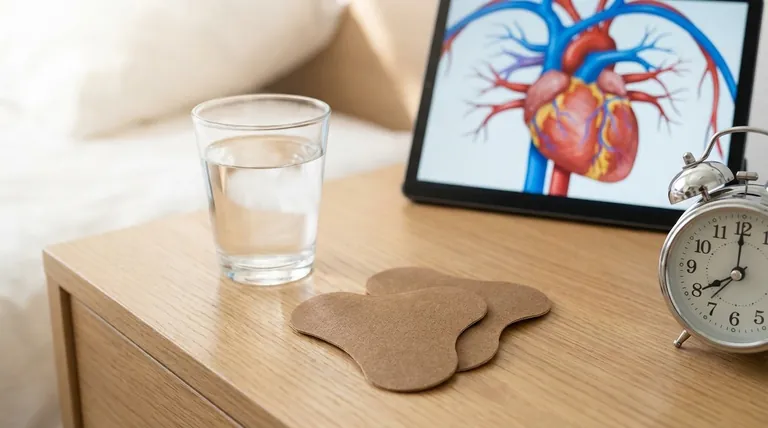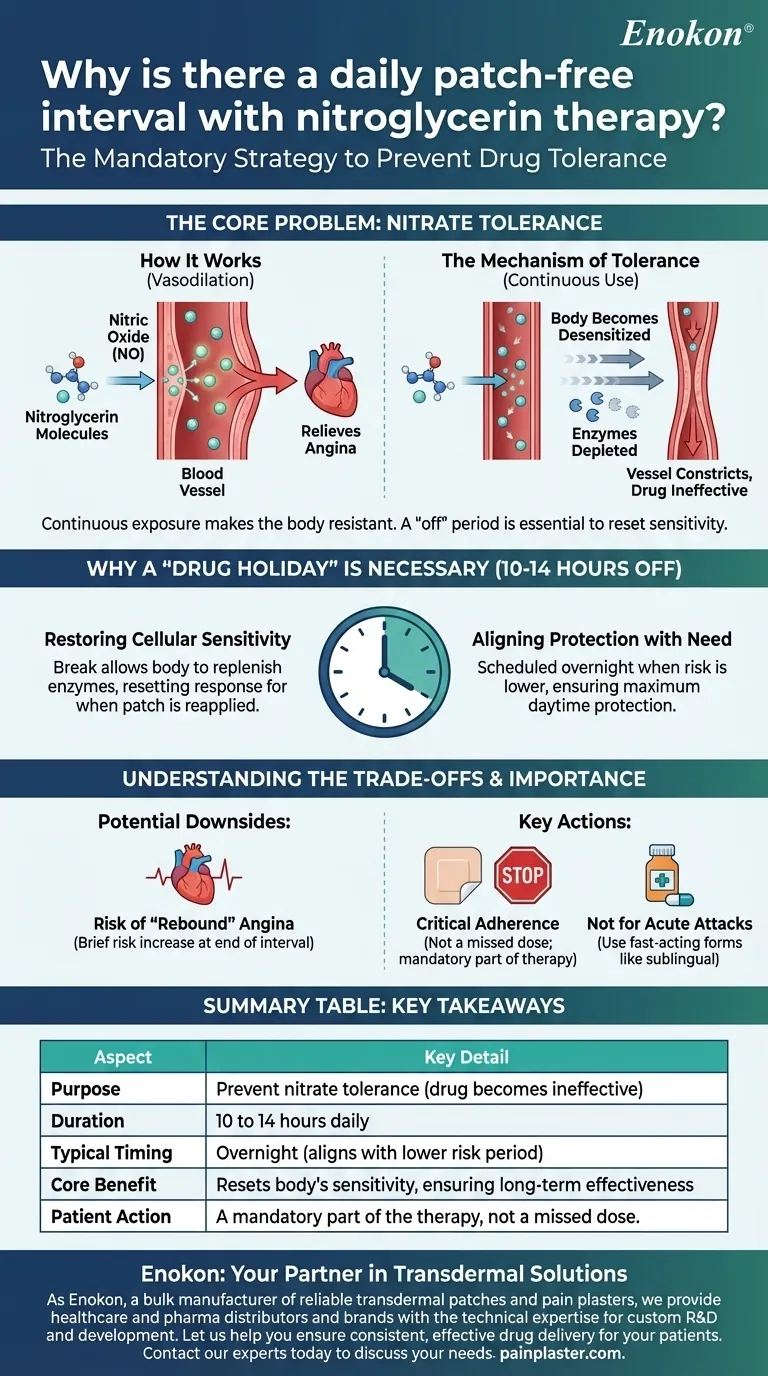The daily patch-free interval with nitroglycerin is a mandatory therapeutic strategy, not an optional break. This 10 to 14-hour period without the patch is essential to prevent drug tolerance, a state where the medication rapidly loses its ability to prevent angina attacks.
The core principle is simple: continuous exposure to nitroglycerin makes the body resistant to its effects. A scheduled daily "off" period is the only way to reset the body's sensitivity and ensure the medication remains effective for long-term treatment.

The Core Problem: Nitrate Tolerance
To understand the patch-free interval, you must first understand why the body stops responding to nitroglycerin with constant use. This phenomenon is known as nitrate tolerance.
How Nitroglycerin Works
Nitroglycerin's primary function is to relax and widen blood vessels, a process called vasodilation.
It achieves this by releasing a molecule called nitric oxide (NO) into the smooth muscle of blood vessel walls. This increased vessel diameter improves blood flow to the heart muscle, relieving and preventing the chest pain of angina.
The Mechanism of Tolerance
When the body is exposed to nitroglycerin continuously, its ability to convert the drug into active nitric oxide diminishes.
Several factors contribute to this. The body's natural systems become desensitized, and key enzymes required for the conversion process can become depleted. The body may also activate counter-regulatory systems that work to constrict blood vessels, directly opposing the drug's intended effect.
The Consequence of Continuous Use
Without a break, the vasodilating effect of the nitroglycerin patch would significantly decrease, often within just 24 hours.
This would leave the patient unprotected from angina attacks despite wearing the patch. The medication essentially becomes ineffective.
Why a "Drug Holiday" is Necessary
The patch-free interval acts as a daily "reset" button for the body's response to the medication. This scheduled break is often referred to as a "drug holiday."
Restoring Cellular Sensitivity
The 10 to 14-hour break allows the body to replenish the enzymes and other co-factors needed to process nitroglycerin effectively.
It gives the cells in the blood vessel walls time to recover their sensitivity to nitric oxide, ensuring a robust response when the patch is reapplied.
Aligning Protection with Need
The patch-free interval is typically scheduled overnight.
This is a deliberate clinical choice, as patients with stable angina are generally at a lower risk of an attack while resting or sleeping. This schedule ensures the medication is providing maximum protection during the day when the patient is most likely to be active.
Understanding the Trade-offs
While essential, the intermittent dosing schedule is not without potential downsides that must be managed. It represents a necessary clinical compromise.
Risk of "Rebound" Angina
Some patients may experience a lower threshold for angina attacks toward the end of the patch-free interval.
This is a known phenomenon where the risk of ischemic events can briefly increase before the next dose is applied.
The Importance of Adherence
It is critical that patients understand this is not a "missed dose" but a core part of the therapy.
Attempting to achieve 24-hour coverage by skipping the patch-free interval is counterproductive and will quickly lead to drug tolerance and treatment failure.
Not for Acute Attacks
It is crucial to remember that the nitroglycerin patch is a prophylactic (preventative) therapy.
It is not designed to treat an acute angina attack that is already in progress. For that, fast-acting formulations like sublingual nitroglycerin are required.
Applying This to Your Goal
Understanding the reason for the patch-free interval is key to ensuring effective and safe long-term management of angina.
- If your primary focus is preventing exertional angina: The patch-free interval ensures the medication is potent and effective during the day when you are most active.
- If your primary focus is ensuring long-term effectiveness: Strictly adhering to the "off" period is the only proven method to prevent the rapid development of tolerance.
- If your primary focus is patient safety: Recognize that the interval is a deliberate therapeutic strategy to maintain the drug's life-saving benefits over time.
Properly managed, the nitroglycerin patch-free interval transforms a physiological limitation into the cornerstone of effective, sustainable angina therapy.
Summary Table:
| Aspect | Key Detail |
|---|---|
| Purpose | Prevent nitrate tolerance (drug becomes ineffective) |
| Duration | 10 to 14 hours daily |
| Typical Timing | Overnight (aligns with lower risk period) |
| Core Benefit | Resets body's sensitivity, ensuring long-term effectiveness |
| Patient Action | A mandatory part of the therapy, not a missed dose |
Need a reliable nitroglycerin or custom transdermal patch solution?
As Enokon, a bulk manufacturer of reliable transdermal patches and pain plasters, we provide healthcare and pharma distributors and brands with the technical expertise for custom R&D and development. Let us help you ensure consistent, effective drug delivery for your patients.
Contact our experts today to discuss your needs.
Visual Guide

Related Products
- Far Infrared Deep Heat Relief Patches Medicated Pain Relief Patches
- Far Infrared Heat Pain Relief Patches Transdermal Patches
- Heating Pain Relief Patches for Menstrual Cramps
- Menthol Gel Pain Relief Patch
- Icy Hot Menthol Medicine Pain Relief Patch
People Also Ask
- How effective are pain relief patches for muscle pain? Target Localized Pain with Transdermal Delivery
- How does the Deep Heat Back Patch work? A Drug-Free Solution for Targeted Pain Relief
- What are pain relief patches and how are they used? A Guide to Safe, Targeted Relief
- How often should pain relief patches be used? Get the Right Schedule for Targeted Relief
- How do pain relief patches compare to other pain relief methods? Discover Targeted, Long-Lasting Relief
















